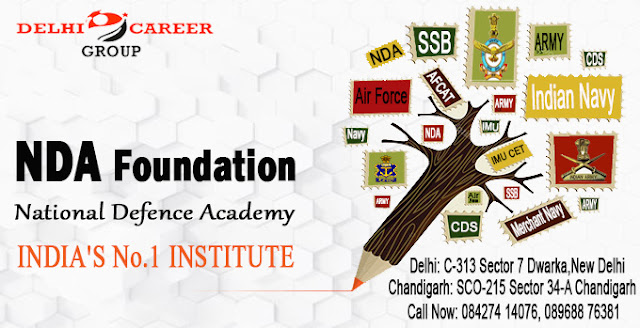Scheme of the Examination– a)Written Exam b) Group tests, intelligence test & obstacles under Service Selection Board(SSB) for written exam qualifiers.
EXAM PATTERN- 2018:-
- Mathematics general ability, Duration- 2 ½ hrs. & Max. Marks-300
- English, General knowledge & Science, Duration- 2 ½ hrs. & Max. Marks-600
- Total marks 900
SSB (Service Selection Board) Interview:
- Written test qualifiers will progress for an SSB interview. Main motive is to determine the personality of the candidates.
- SSB Training consists-Five days of personality & intelligence test
Day 1: SSB Basic intelligence test will be taken.
Day 2:SSB Psychological test will be taken.
Day 3 & Day 4: SSB Group testing will be taken by Group testing officers ( GTO ).
Day 5: Conference by SSB
* Group discussion ( GD)& Personal interview (PI) can also be taken in between 2-4 day
INTELLIGENCE AND PERSONALITY TEST:
In order to assess basic
intelligence,verbal & non- verbal intelligence test is taken for the
candidates. Candidates are also supposed to go through group tests,
i.e. group discussions(GD), group-planning, outdoor group tasks and to
give brief lectures on particular topics. These tests are conducted to
examine the mental ability of the candidates.
NDA EXAM SYLLABUS:-
Paper I (Mathematics) –
Algebra, Matrices and Determinants,
Trigonometry, Analytical Geometry of two and three dimensions,
Differential Calculus, Integral Calculus and Differential equations,
Vector Algebra, Statistics and Probability, Probability
Paper II- General Ability Test
Part A (English) – Grammar and usage, vocabulary, comprehension and cohesion in extended texts to test the candidate’s proficiency in English.
Part B (General Knowledge) – The
question paper of General Knowledge will cover all the subjects:
Physics, Chemistry, General Science, Social Studies, Geography and
Current Events.These topics should not be taken as complete and
questions on the same subject not specifically mentioned in the syllabus
can be asked as well.
Section A Physics-
Static and Current Electricity: Conductors and Nonconductors. Ohm’s Law. Simple Electrical Circuits. Heating, Lighting and Magnetic effects of Current.Measurement of Electrical Power. Primary and Secondary Cells. Use of X-rays,
Natural and Artificial Magnets.
General Principles in the working of the following: Simple Pendulum, Simple Pulleys, Siphon, Levers, Balloon, Pumps, Hydrometer, Pressure Cooker, Thermos Flask, Gramophone, Telegraphs, Telephone, Periscope, Telescope, Microscope, Mariner’s, Lightning Conductors & Safety Fuses. Physical Properties and States of Matter Mass Weight, Volume, Density and Specific Gravity, Principle of Archimedes, Pressure Barometer,
General Principles in the working of the following: Simple Pendulum, Simple Pulleys, Siphon, Levers, Balloon, Pumps, Hydrometer, Pressure Cooker, Thermos Flask, Gramophone, Telegraphs, Telephone, Periscope, Telescope, Microscope, Mariner’s, Lightning Conductors & Safety Fuses. Physical Properties and States of Matter Mass Weight, Volume, Density and Specific Gravity, Principle of Archimedes, Pressure Barometer,
Motion of Object:
Velocity and Acceleration. Newton’s Laws
of Motion. Force and Momentum.Parallelogram of Forces.Stability and
Equilibrium of bodies. Gravitation, elementary ideas of Work, Power and
Energy. Effects of Heat.
Sound waves and their properties. Simple musical instruments.
Rectilinear propagation of Light. Reflection and refraction.
Spherical mirrors and lenses. Human Eye.
Sound waves and their properties. Simple musical instruments.
Rectilinear propagation of Light. Reflection and refraction.
Spherical mirrors and lenses. Human Eye.
Section B –Chemistry
Acids, Bases and Salts.
Carbon-different forms. Fertilizers-Natural and Artificial.
Materials used in preparation of
substances like Soap, Glass, Ink, Paper, Cement, Paints, Safety Matches
and Gunpowder. Elementary ideas about the Structure of Atom, Atomic
Equivalent and Molecular Weights & Valency.
Physical and Chemical changes. Elements,
Mixtures, and Compounds, Symbols, Formulae and simple Chemical
Equations. Law of Chemical Combination [excluding problems). Properties
of Air and Water.
Preparation and Properties of Hydrogen, Oxygen, Nitrogen and Carbon dioxide, Oxidation and Reduction.
Elementary knowledge of human body and
its important organs. Common Epidemics, causes and
prevention.Food-Source of energy for man. Constituents of food Balanced
diet. Difference between the living and non-living.
Basis of Life-Cells, Protoplasm’s and Tissues.
Growth and Reproduction in Plants and Animals.The Solar System, Achievements of Eminent Scientists.
Section D – History, Freedom Movement, etc.
Elementary knowledge of Five-Year Plans of India.
Panchayati Raj, Cooperatives and Community Development.
Bhoodan. Sarvodaya. National Integration and Welfare State.
Basic Teachings of Mahatma Gandhi.
Forces shaping the modern world, A broad survey of Indian History, Culture and Civilization.
Freedom Movement in India.
Elementary study of Indian Constitution and Administration.
Panchayati Raj, Cooperatives and Community Development.
Bhoodan. Sarvodaya. National Integration and Welfare State.
Basic Teachings of Mahatma Gandhi.
Forces shaping the modern world, A broad survey of Indian History, Culture and Civilization.
Freedom Movement in India.
Elementary study of Indian Constitution and Administration.
Section E –Geography
The Earth, its shape and size. Latitudes
and Longitudes. Concept of Time. International Date Line. Movements of
Earth & their effects.
Origin of Earth. Rocks & their
classification. Weathering Mechanical & Chemical. Earthquakes and
Volcanoes. Ocean Currents and Tides. Atmosphere and its composition;
Temperature and Atmospheric Pressure; Planetary Winds; Cyclones and
Anticyclones; Humidity, Condensation and Precipitation: Types of
Climate. Major Natural regions of the World.
Regional Geography of India-Climate,
Natural vegetation. Mineral and Power resources; location and
distribution of agricultural and industrial activities. Important Sea
Ports & Sea; land & air routes of India. Imports and Exports of
India.
Section F -Current Events-
Cultural, Sport, prominent
personalities, events in the context of India and world& main events
of India happened in recent years.


No comments:
Post a Comment